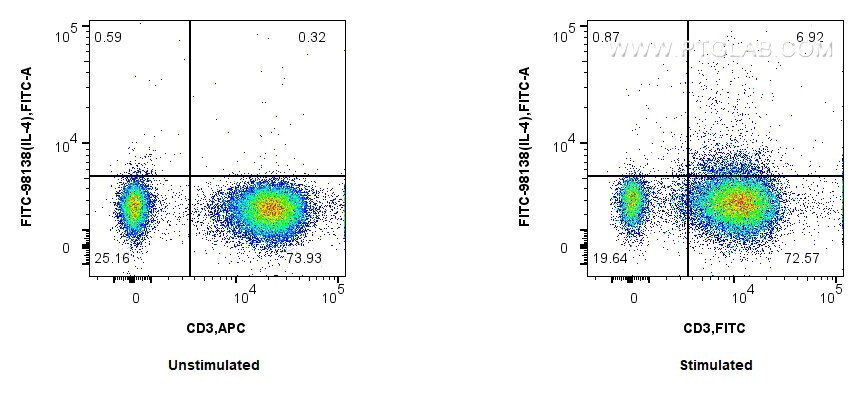Tested Applications
| Positive FC (Intra) detected in | PMA, Ionomycin and Brefeldin A treated human PBMCs |
Recommended dilution
| Application | Dilution |
|---|---|
| Flow Cytometry (FC) (INTRA) | FC (INTRA) : 5 ul per 10^6 cells in a 100 µl suspension |
| This reagent has been pre-titrated and tested for flow cytometric analysis. The suggested use of this reagent is 5 ul per 10^6 cells in a 100 µl suspension or 5 ul per 100 µl of whole blood. | |
| Sample-dependent, Check data in validation data gallery. | |
Product Information
FITC-98138 targets IL-4 in FC (Intra) applications and shows reactivity with human samples.
| Tested Reactivity | human |
| Host / Isotype | Rabbit / IgG |
| Class | Recombinant |
| Type | Antibody |
| Immunogen |
CatNo: Eg0104 Product name: Recombinant Human IL-4 protein (Myc Tag, His Tag) Source: mammalian cells-derived, pHZ-KIsec Tag: Myc & 6*His Domain: 25-153 aa of BC070123 Sequence: HKCDITLQEIIKTLNSLTEQKTLCTELTVTDIFAASKNTTEKETFCRAATVLRQFYSHHEKDTRCLGATAQQFHRHKQLIRFLKRLDRNLWGLAGLNSCPVKEANQSTLENFLERLKTIMREKYSKCSS Predict reactive species |
| Full Name | interleukin 4 |
| Calculated Molecular Weight | 153 aa, 17 kDa |
| GenBank Accession Number | BC070123 |
| Gene Symbol | IL-4 |
| Gene ID (NCBI) | 3565 |
| Conjugate | FITC Plus Fluorescent Dye |
| Excitation/Emission Maxima Wavelengths | 495 nm / 524 nm |
| Form | Liquid |
| Purification Method | Protein A purification |
| UNIPROT ID | P05112 |
| Storage Buffer | PBS with 0.09% sodium azide and 0.5% BSA, pH 7.3. |
| Storage Conditions | Store at 2-8°C. Avoid exposure to light. Stable for one year after shipment. |
Background Information
IL-4 is a cytokine produced by CD4+ T cells in response to helminthes and other extracellular parasites. It promotes the proliferation and differentiation of antigen presenting cells. IL-4 also plays a pivotal role in antibody isotype switching and stimulates the production of IgE. This cytokine has been applied in the treatment of autoimmune disorder like multiple myeloma, cancer, psoriasis, and arthritis. IL-4 has also been extensively applied to inhibit detrimental effect of Th1. It may promote the growth of epithelial tumors by mediating increased proliferation and survival.
Protocols
| Product Specific Protocols | |
|---|---|
| FC protocol for FITC Plus IL-4 antibody FITC-98138 | Download protocol |
| Standard Protocols | |
|---|---|
| Click here to view our Standard Protocols |




